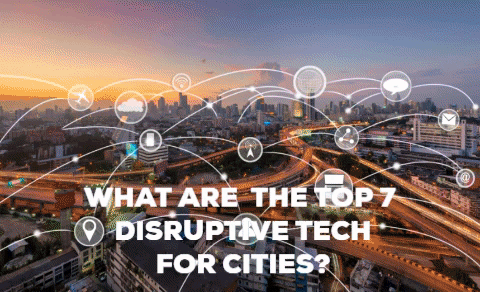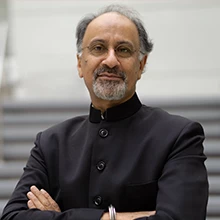 Photo by Krunja / Shutterstock
Photo by Krunja / Shutterstock
The new informational, transactional, and operational technologies – popularly termed “Industry 4.0” – are likely to change the shape of cities, and may well require a rethinking of how we define “density.”
Cities generate over 80% of global economic activity, helping hundreds of millions of people lift themselves out of extreme poverty. If we manage well the congestion forces, for example, tackling pollution, easing congestion, and addressing a lack of affordability, cities are the drivers of productivity and innovation. However, the speed and scale of urbanization brings challenges, particularly for the poor and vulnerable.
Therefore, the city of the future will have a different economic base. The future of work will be one based more on the:
- gig economy, which is based on flexible, temporary, or freelance jobs, often involving connecting with clients or customers through an online platform; and
- sharing economy, which involves short-term peer-to-peer transactions, often involving some type of online platform that connects buyers and seller.
And with technology come changes in connectivity and proximity. These types of work will have a different infrastructure base. For example, they won’t need networked services, they will instead be on micro-grids, and they’ll be more home-based.
So, the city of the future won’t be one of connectivity and proximity, but one of livability to attract smart people and bring about innovation spillovers and productivity, and one about resilience to ensure business continuity and an ability to constantly adapt.
Download report: Which Way to Livable and Productive Cities? A Road Map for Sub-Saharan Africa
Physical density also reduces infrastructure costs per consumer, as the costs of networked infrastructure can be shared across a larger number of users. Dense urban structures are also more energy efficient; research by Philip Rode shows that tall buildings are an optimum shape due to their relatively low surface to volume ratio and, hence, heat losses.
As more firms and residents move to a city, land prices increase, environmental quality typically decreases and demand for transportation rises. To support a thriving economy and vibrant communities, city leaders continuously need to reduce these congestion costs to the best of their abilities, knowing that improvements tend to attract additional demand. In this race, at any point in time, there is a tension between agglomeration benefits and congestion costs.
Technological advances in the latter part of the 20th century and early 21st century have been gradually reshaping density patterns within cities.
Falling costs of urban transport have led to both spatial concentration of jobs and dispersion of homes in countries that span the development spectrum , as seen in high-income United States, upper middle-income China, and lower middle-income India.
The roll-out of renewable energy is reducing CO2 emissions, with medium- to low-density housing in some cases enabling greater savings in CO2 emissions than higher density development because of the greater amount of space for collection of renewable energy. But as we look further down the road toward the middle of the 21st century, city leaders are entering a realm of “unknown-unknowns,” as extrapolations of past technical advances are unlikely to anticipate future paths of urban development.
Blog post: Top 7 disruptive technologies for cities
Much of the first generation “informational technologies” use the exponential growth of data. Examples include the internet of things, big data analytics, cloud computing, and blockchain. The fundamental driver is the falling cost of computing. The main effect is to lower coordination costs. Many of these technologies have been around since the 20th century.
The second generation is “transactional technologies” that digitize business models. Examples include the sharing economy, gig economy, and digital platforms. The fundamental driver is falling cost of matching demand and supply. The main effect is to reduce information asymmetries between consumers and producers. Many of these technologies are early 21st century innovations.
But the frontier, as we see it, is “operational technologies” that combine data with automation. Examples include autonomous vehicles, off-grid energy systems, hyperloop, robotics, 3-D printing, artificial intelligence, and machine learning. The fundamental driver is the falling cost of routine functions. These disruptors are at the frontier of innovation and are likely to fundamentally reshape notions of density and economic geography.
To help city leaders move from the realm of “unknown-unknowns” toward making more informed choices in anticipating and planning for the future spatial organization of cities, at the World Bank, we are taking stock of emerging technologies that influence the decisions of firms on where to locate production or service centers and of households on where to live. And while information and transactional technologies are important, we need to start getting a handle on operational technologies – as these can fundamentally disrupt the built environment.
On the one hand, we can think of atomized communities not needing transport or energy grids where residents can get to jobs via individualized mass transit. Such a scenario can have major equity ramifications as a large share of the population in developing countries can be excluded from these innovations.
On the other hand, we can think of vibrant polycentric cities where fast transport can enable multiple job and residential centers where a larger share of urban residents can access amenities. The balance between lopsided and leapfrog disruptions will depend on institutional capabilities and preferences of residents.
We are also developing an analytic framework to examine the implications of these interactions on urban spatial structures and efficiency (agglomeration economies), equity, and the environment; and considering how changes in labor supply from the gig economy is changing density patterns.
Technology has enormous promise in transforming how cities deliver services to their citizens, and, if used appropriately, doing it in a way that fundamentally alters not just the mode of delivery but its underlying economics and financing . We at the World Bank are keen to support this transformation for urban citizens.
- Subscribe to our Sustainable Cities and Communities newsletter
- Follow @WBG_Cities on Twitter





Join the Conversation